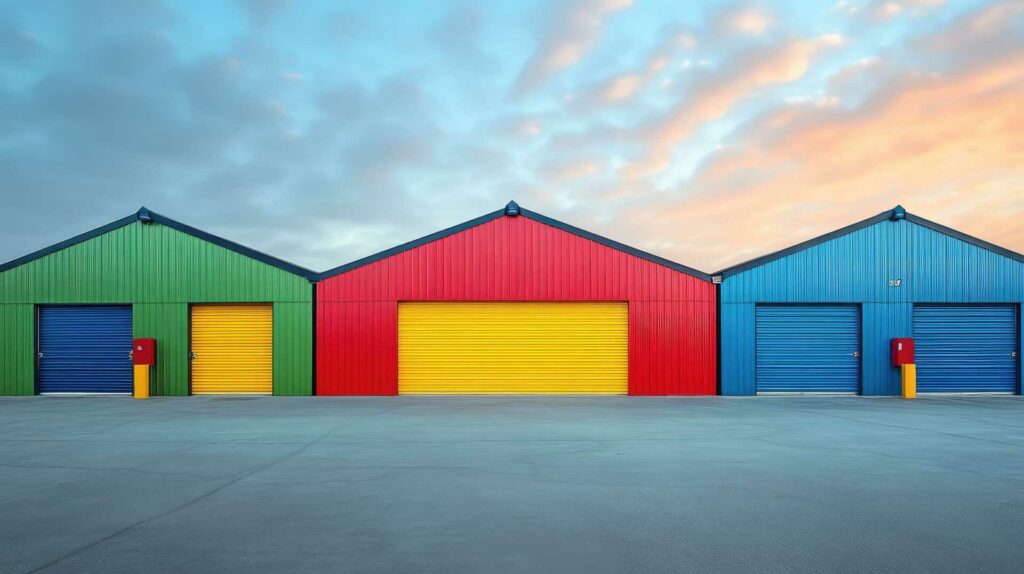
Contents
When it comes to selecting building designs, why choose energy-efficient metal structures? These structures can cut down your operating costs and lessen your environmental impact while offering enhanced sustainability features that extend beyond mere energy savings. By integrating elements like solar panels and efficient HVAC systems, these buildings provide a pathway to long-term savings and a commitment to a more eco-friendly future. The benefits don’t stop there; the creative insulation solutions and smart building technologies offer a glimpse into a more efficient and eco-conscious way of constructing our environments.
Key Takeaways
- Significant cost savings on long-term operational expenses.
- Reduced environmental impact and carbon footprint.
- Enhanced insulation solutions for optimal temperature control.
- Integration of energy-saving lighting and HVAC systems.
- Incorporation of solar panels and smart technologies for sustainability.
Benefits of Energy Efficiency
Opting for energy-efficient metal building designs can result in significant cost savings on long-term operational expenses. By choosing eco-friendly materials and implementing energy-saving features, you can enjoy reduced energy bills and contribute to a greener environment.
Energy savings are a key benefit of investing in energy-efficient metal building designs. These structures are designed to minimize energy consumption by utilizing strategies such as improved insulation, energy-saving lighting, and advanced HVAC systems. By reducing the amount of energy needed to heat, cool, and power the building, you can lower your monthly utility costs and decrease your overall environmental impact.
Moreover, sustainability benefits play an essential role in energy-efficient metal building designs. These buildings are constructed using environmentally friendly materials that are both durable and recyclable. By choosing eco-friendly materials, you can reduce waste and minimize the environmental footprint of your construction project.
Additionally, energy-efficient designs often incorporate features like solar panels or green roofs, further enhancing the building’s sustainability and reducing its reliance on non-renewable energy sources.
Cost Savings Over Time
Embracing energy-efficient metal building designs can lead to substantial cost savings over time through reduced utility expenses and enhanced operational efficiency. When considering the long-term savings and energy efficiency benefits of eco-friendly design, here are some key points to keep in mind:
Lower Energy Bills: Energy-efficient metal buildings are designed to minimize energy consumption, resulting in reduced electricity and heating/cooling costs. Over time, these savings can significantly impact your overall expenses.
Minimal Maintenance Costs: Energy-efficient metal buildings require less maintenance than traditional structures, thanks to durable materials and advanced construction techniques. This translates into lower repair and upkeep expenses in the long run.
Tax Incentives: Many governments offer tax incentives and rebates for implementing energy-efficient practices in buildings. By choosing an eco-friendly design for your metal building, you may qualify for these financial benefits, further increasing your cost savings over time.
Increased Property Value: Energy-efficient buildings are in high demand due to their environmental benefits and cost-saving potential. Should you decide to sell or lease your metal building in the future, its eco-friendly design can attract higher resale or rental values, enhancing your overall return on investment.
Environmental Impact Reduction
Reducing the environmental impact becomes paramount to further enhance the benefits of energy-efficient metal building designs. By selecting energy-efficient metal building designs, you’re actively contributing to reducing your carbon footprint. These structures are constructed using eco-friendly practices that minimize waste and maximize energy efficiency.
Metal buildings have the advantage of being highly recyclable, with a significant amount of reused content used in their construction. This means fewer raw materials are needed, reducing the demand for additional resources and lessening the environmental impact of the building process.
Moreover, the energy efficiency of metal buildings leads to lower energy consumption over time. This not only results in cost savings for you but also contributes to a more environmentally friendly future by decreasing the reliance on fossil fuels and reducing greenhouse gas emissions.
Eco-friendly construction practices integrated into energy-efficient metal building designs help create environmentally conscious structures and promote a healthier planet for future generations. By choosing these eco-conscious solutions, you’re making a positive impact on the environment and aligning yourself with a community of like-minded individuals who prioritize green choices.
Improved Insulation Solutions
Improved insulation solutions enhance the energy efficiency of metal building designs and play a crucial role in maintaining ideal indoor temperature levels.
When considering insulation technology and its impact on thermal performance, here are some key factors to keep in mind:
Reflective Insulation: Utilizing materials with reflective surfaces can help reduce heat transfer through radiation. Reflective insulation is particularly effective in hot climates by bouncing radiant heat away from the building, keeping interiors cooler.
Spray Foam Insulation: This type of insulation expands to fill gaps and crevices, providing an airtight seal that minimizes heat loss. Spray foam insulation offers excellent thermal performance and can effectively control indoor temperatures in various weather conditions.
Rigid Board Insulation: Made from compressed fibers or foam boards, rigid insulation is durable and moisture-resistant. It’s a versatile option that enhances thermal efficiency by reducing heat flow through walls, roofs, and floors.
Insulated Metal Panels: These panels combine insulation and exterior cladding in a single product, offering a streamlined solution for energy-efficient building envelopes. Insulated metal panels provide superior thermal performance while maintaining structural integrity.
Energy-Efficient Lighting Options
Implementing energy-efficient lighting options can reduce electricity consumption and enhance the durability of metal building designs. When considering lighting solutions for your metal building, incorporating natural daylighting is an excellent way to minimize dependence on artificial lighting during daylight hours. This lowers energy usage and creates a more comfortable and welcoming indoor environment.
Choosing energy-efficient fixtures such as LED lights can greatly decrease electricity costs while providing ample illumination. LED lights are long-lasting and consume less energy than traditional incandescent or fluorescent bulbs, making them an ideal choice for eco-friendly metal building designs.
To further enhance energy efficiency, incorporating motion sensor technology can make sure that lights are only activated when needed. Motion sensor lights automatically switch on when someone enters a room and turn off when the area is empty, preventing unnecessary energy consumption.
Additionally, utilizing dimmable lighting systems allows for adjusting light levels based on specific needs, saving energy by not exceeding the necessary light levels. Dimmable lights can create different atmospheres within a space while conserving electricity.
HVAC System Efficiency
When it comes to HVAC system efficiency in metal building designs, you’ll want to focus on smart system design. Incorporating energy-saving features like programmable thermostats and variable-speed drives enhances comfort and greatly decreases energy consumption and environmental impact.
HVAC System Design
Optimizing the HVAC system design in metal buildings is crucial for maximizing energy efficiency and maintaining comfortable indoor environments. When it comes to HVAC system design, there are several key factors to take into account:
Right-Sized Equipment: Making sure that the HVAC system is appropriately sized for the building’s needs helps prevent energy wastage and improves overall efficiency.
Proper Insulation: Effective insulation reduces the load on the HVAC system by maintaining the indoor temperature stable, leading to lower energy consumption.
Zoning: Implementing zoning systems allows for personalized temperature control in different areas of the building, optimizing energy usage based on specific requirements.
Regular Maintenance: Scheduled upkeep of the HVAC system ensures it operates at peak efficiency, minimizing energy consumption and extending the system’s lifespan.
Energy-Saving Features
To enhance the energy efficiency of your HVAC system, consider incorporating advanced features that can greatly reduce energy consumption and operating costs. Energy-saving materials and green building practices play a pivotal role in environmentally-friendly construction and eco-conscious designs.
When designing your HVAC system, opt for energy-efficient components such as high-efficiency air filters, programmable thermostats, and variable-speed drives. These features help regulate temperature and airflow more effectively, resulting in significant energy savings over time.
Furthermore, integrating smart technologies like automated controls and sensors can enhance your system’s efficiency by adjusting settings based on occupancy and external conditions. Insulating ductwork and using reflective roofing materials are additional strategies that contribute to energy conservation within your metal building.
Environmental Impact
Enhancing the ecological impact of your HVAC system’s efficiency requires strategic consideration of energy-saving components and smart technologies. Improving your HVAC system can greatly reduce your building’s carbon footprint and contribute to a more eco-friendly environment.
Here are four ways to enhance your HVAC system’s efficiency:
Utilize Renewable Resources: Integrate sustainable energy sources such as solar panels or geothermal systems to power your HVAC system, decreasing dependence on traditional energy sources and lowering emissions.
Invest in Energy-Efficient HVAC Units: Upgrade to high-efficiency HVAC units that consume less energy while providing the same level of comfort, helping to reduce your building’s overall energy consumption.
Implement Smart Thermostats: Use intelligent thermostats to regulate temperatures efficiently, adjusting settings based on occupancy and outside conditions to optimize energy usage.
Regular Maintenance: Schedule routine upkeep for your HVAC system to make sure it operates at peak efficiency, prolonging its lifespan and reducing energy waste.
Solar Panel Integration
Integrating solar panels onto metal buildings can greatly enhance their energy efficiency and environmental friendliness. When it comes to solar panel efficiency, metal buildings provide an ideal platform for capturing and utilizing renewable energy. The sleek, flat surfaces of metal roofs offer ample space for solar panels, maximizing exposure to sunlight throughout the day.
Metal buildings are structurally sturdy and can easily support the weight of solar panels. This compatibility ensures a smooth integration that enhances the building’s energy efficiency and also contributes to a cleaner environment by reducing reliance on non-renewable energy sources.
By harnessing solar power, you can significantly reduce your electricity bills while lowering your carbon footprint.
The process of renewable energy integration through solar panels is a forward-thinking approach that aligns with the global shift towards eco-friendly practices. By incorporating solar panels into your metal building design, you actively participate in the movement toward a greener future.
Embracing solar technology benefits you economically and allows you to make a positive impact on the environment.
Smart Building Technologies
Consider implementing cutting-edge smart building technologies to transform the efficiency and functionality of your metal building design. By integrating smart technology and building automation systems, you can optimize energy usage, enhance security, and improve overall operational efficiency.
Here are four key ways smart building technologies can transform your metal building:
Energy Management: Implementing smart technology allows you to monitor and control energy consumption in real time. Automated systems can adjust lighting, heating, and cooling based on occupancy, leading to significant energy savings and reduced utility costs.
Predictive Maintenance: Utilize building automation to conduct predictive maintenance tasks. By analyzing data from various sensors and systems, you can detect issues before they escalate, preventing costly repairs and minimizing downtime.
Enhanced Security: Smart building technologies offer advanced security features such as surveillance cameras, access control systems, and alarms that can be managed remotely. This ensures a safer environment for occupants and protects valuable assets within the metal building.
Occupant Comfort: Building automation systems can create personalized environments by adjusting factors like temperature and lighting based on individual preferences. This level of customization enhances occupant comfort and satisfaction, increasing productivity and well-being.
Incorporating smart building technologies into your metal building design boosts efficiency and enhances the overall experience for occupants and stakeholders.
LEED Certification Possibilities
Consider the significant benefits of pursuing LEED Certification for your metal building project.
Achieving this certification showcases your commitment to environmental sustainability by implementing energy-efficient practices and materials.
It not only contributes to a greener future, but it also enhances the overall efficiency and performance of your building.
LEED Certification Benefits
To achieve LEED certification for your metal building design, it’s crucial to prioritize energy-saving strategies and environmentally friendly practices from the beginning. By incorporating eco-conscious design principles and green building techniques, you can access numerous benefits for your project:
Energy Savings: Implementing energy-conserving systems and technologies reduces operational costs and diminishes your environmental impact.
Improved Indoor Air Quality: Using materials with low volatile organic compounds (VOCs) and enhancing ventilation systems can boost the health and well-being of occupants.
Water Efficiency: Installing water-saving fixtures and implementing efficient irrigation systems can notably decrease water consumption.
Enhanced Marketability: Achieving LEED certification demonstrates your dedication to sustainability and attracting environmentally aware tenants, investors, and stakeholders.
Environmental Sustainability Impact
Embrace the potential for significant environmental sustainability impact through the pursuit of LEED certification for your metal building design. Incorporating sustainable practices and eco-friendly materials benefits the environment and enhances the overall quality of your building. By focusing on green building principles, you can reduce your carbon footprint and contribute to a healthier planet. Achieving LEED certification showcases your commitment to sustainable construction and provides numerous advantages, from energy savings to improved indoor air quality.
| Sustainable Practices | Eco-Friendly Materials | Green Building |
|---|---|---|
| Efficient insulation methods | Recycled steel components | Solar panel integration |
| Water-saving fixtures | Sustainable wood alternatives | Green roof installations |
| LED lighting systems | Low VOC paint options | Rainwater harvesting systems |
| Passive cooling techniques | Energy-efficient windows | Permeable pavement solutions |
| Daylight harvesting strategies | Reflective roofing materials | Native landscaping choices |
Summary
So why choose energy-efficient metal building designs?
Like a shining beacon in the night, they offer a path toward long-term cost savings, environmental stewardship, and a brighter future for all.
By embracing energy efficiency, you’re not just building structures – you’re building a legacy of sustainability and responsibility.
Make the smart choice today and reap the benefits for years to come.
Recent Posts
3 Tips for Personalized Metal Garage Solutions
Finding personalized metal garage solutions can transform your cluttered space into a functional haven. By
Guide to Lasting Metal Structures for Homes
Imagine a sturdy metal garage standing proud against the fiercest storms, much like a lighthouse
What Are Affordable Metal Garage Options for Farms?
Imagine you’re managing a bustling farm like Smith’s Acres, where every inch of space counts.




